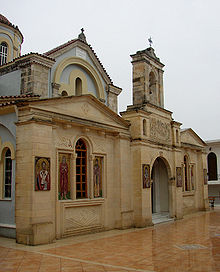- Mesara Plain
-
The Mesara or Messara Plain (πεδιάδα της Μεσ(σ)αράς) is an illuvial plain in southern Crete, stretching about 50 km west-to-east and 7 km north-to-south, making it the largest plain in Crete.
On a hill at its west end are the ruins of Minoan Phaistos[1]; near the middle are the ruins of the ancient city of Gortys.
Since 1500 BC the plain has grown up to 6 km due to a build up of illuvial sediment. Clays from the Mesara have been found to be the source of significant amounts of Cretan Minoan pottery; soil and rock types from the fringes of the Mesara, particularly the foothills of the Asterousia Mountains at the south and the foothills to the north within the Psiloritis Mountains.[2]
See also
References
- ^ C.Michael Hogan, Phaistos Fieldnotes, The Modern Antiquarian (2007)
- ^ Joseph W. Shaw, A Lm Ia Ceramic Kiln in South-Central Crete: Function and Pottery Production, 2001, ASCSA, 172 pages ISBN 0876615302
Literature
- Livingstone Vance Watrous, Plain of Phaistos: Cycles of Social Complexity in the Mesara Region of Crete, Cotsen Institute of Archaeology at UCLA (2006), ISBN 1-931745-14-5.
Coordinates: 35°02′14″N 24°50′46″E / 35.03722°N 24.84611°E
Categories:- Heraklion Prefecture
- Landforms of Greece
- Greece geography stubs
Wikimedia Foundation. 2010.

